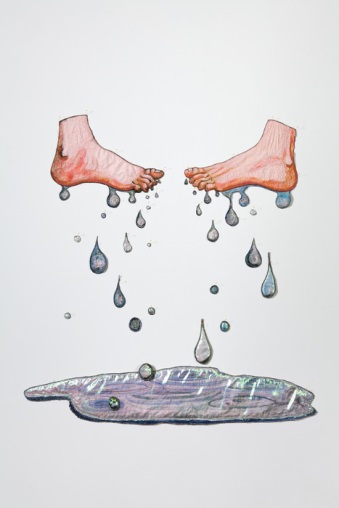Bicycle helmets reduce the risk for head injury by as much as 85% and reduce the risk for brain injury by as much as 88%.

The acid in your stomach is strong enough to dissolve razorblades
While you certainly shouldn’t test the fortitude of your stomach by eating a razorblade or any other metal object for that matter, the acids that digest the food you eat aren’t to be taken lightly. Hydrochloric acid, the type found in your stomach, is not only good at dissolving the pizza you had for dinner but can also eat through many types of metal.

"Witzelsucht" is a condition that causes people to have an uncontrollable urge to make jokes.
Comedians, clowns, and comics like to make people laugh. But for people with witzelsucht, telling silly stories and making groan-worthy puns is an uncontrollable impulse. According to a 2016 article published in The Journal of Neuropsychiatry and Clinical Neurosciences, patients with the condition can't resist "excessive and often inappropriate joking and facetious humor" as well as "a childish or silly excitement."

The sponge is the only multicellular animal
without a nervous system.

The word "unfriend" was first used in 1659.
When you disconnect with someone on social media, you might say that you've "unfriended" them. The now-common word was even the New Oxford American Dictionary Word of the Year in 2009. But it turns out that "unfriend" is much older than you might expect. According to The Globe and Mail, the word "unbefriended" is cited several times in the Oxford English Dictionary beginning in 1629. But it wasn't until 1659 that Thomas Fuller used the word as we know it today. In his book The Appeal of Injured Innocence, Fuller wrote, "I hope, sir, that we are not mutually Unfriended by this Difference which hath happened betwixt us."

The smallest bone in the human body is the
"stapes." This bone, found in the ear, is only
0.25 to 0.33 cm long (0.10 to 0.13 inches)
and weighs only 1.9 to 4.3 milligrams.

The skin of an adult human covers about
18-20 square feet
(~2 square meters) and
weighs about 6 lb (2.7 kg).

The aorta is nearly the diameter of a garden hose.
The average adult heart is about the
size of two fists, making the size of the aorta quite impressive. The artery needs to be so
large as it is the main supplier of rich, oxygenated blood to the rest of the body.

The brain operates on the same amount of power as 10watt
The cartoon
image of a light bulb over your head when a great thought occurs isn’t too far off the
mark. Your brain generates as much energy as a small light bulb even when you’re
sleeping.

Heaviest onion
The world is just a great big onion,” sang Marvin Gaye and Tammi Terrell. It’s a lyric that rings especially true in Leicestershire, where champion gardener Tony Glover’s eye-watering 8.5kg (18lb 12oz) beast could make an entire kitchen cry. It took more than a year to grow, measures 81cm (32in) around and would be enough to make 250 onion bhajis. Glover, 50, has been cultivating veg since his teens and really, ahem, knows his onions: “I give them a nitrogen-rich food and have to make sure the humidity is just right. I’ve also got grow-lights fitted to the greenhouse to simulate the sun when the days get shorter.” That’s shallot of effort.

It takes 17 muscles to smile and 43 to frown
Unless you’re trying to give your face a
bit of a workout, smiling is a much easier option for most of us. Anyone who’s ever
scowled, squinted or frowned for a long period of time knows how it tires out the face
which doesn’t do a thing to improve your mood.

The surface area of a human lung is equal to a tennis court.
In order to more
efficiently oxygenate the blood, the lungs are filled with thousands of branching bronchi
and tiny, grapelike
alveoli. These are filled with microscopic capillaries which oxygen
and carbon dioxide. The large amount of surface area makes it easier for this exchange to
take place, and makes sure you stay properly oxygenated at all times.

A full bladder is roughly the size of a soft ball.
No wonder you have to run to bathroom
when you feel the call of the wild. The average bladder holds about 400-800
cc of fluid
but most people will feel the urge to go long before that at 250 to 300 cc.

Octopuses lay 56,000 eggs at a time.
These eight-legged sea creatures lay a staggering 56,000 eggs at one time. Each egg—which biologist Jim Cosgrove describes as "a gleaming white tear-drop about the size of a grain of rice"—comes out on its own, then is gathered up along with all of the other eggs and kept in a protective braid-like den until they're ready to hatch.

Stroke (""brain attack"") is the 3rd leading
cause of death in the US.

Your eyes are always the same size from birth but your nose and ears never stop
When babies look up at you with those big eyes, they’re the same size that they’ll be carrying around in their bodies for the rest of their lives. Their ears and nose,however, will grow throughout their lives and research has shown that growth peaks in seven year cycles.

The brain is much more active at night than during the day.
Logically, you would
think that all the moving around, complicated calculations and tasks and general
interaction we do on a daily basis during our working hours would take a lot more brain
power than, say, lying in bed. Turns out, the opposite is true. When you turn off your
brain turns on. Scientists don’t yet know why this is but you can thank the hard work of
your brain while you sleep for all those pleasant dreams.

Nerve impulses to and from the brain travel as fast as 170 miles per hour.
Ever
wonder how you can react so fast to things around you or why that stubbed toe hurts right
away? It’s due to the superspeedy
movement of nerve impulses from your brain to the
rest of your body and vice versa, bringing reactions at the speed of a high powered luxury

If you were to write out every number (one, two, three, etc.), you wouldn't use the letter "b" until you reached one billion.
You'll have to trust us on this one: If you spelled out every number, you'd get all the way to one billion before you'd need the second letter in the alphabet.

Scientists say the higher your I.Q. the more you dream.
While this may be true, don’t take it as a sign you’re mentally lacking if you can’t recall your dreams. Most of us don’t remember many of our dreams and the average length of most dreams is only 23 seconds–barely long enough to register.

During your lifetime, you will produce enough saliva to fill two swimming pools.
Saliva plays an important part in beginning the digestive process and keeping the mouth
lubricated, and your mouth produces quite a bit of it on a daily basis.

Tallest dog ever
The lankiest canine in recorded history was Zeus, a great dane that measured 1.12 metres (44in) tall until his death last year. The lofty mutt was owned by the Doorlag family from Michigan and his record-breaking career began when Kevin Doorlag was watching TV: “We saw [previous title-holder] Giant George on Oprah Winfrey and I was like, ‘Man, Zeus has got to be right up there.’ We tried to measure him but he’s such a baby, he was scared of the tape measure.” Zeus was indeed a gentle giant and a part-time pet therapy dog. When he stood on his hind legs, he was 2.2m (7ft 4in) tall, more than a third of the height of an average giraffe.

Feet have 500,000 sweat glands and can produce more than a pint of sweat a day.
With that kind of sweatproducing
power it’s no wonder that your gym shoes have a
stench that can peel paint. Additionally, men usually have much more active sweat glands
than women.

A simple, moderately severe sunburn damages the blood vessels extensively
How extensively? Studies have shown that it can take four to fifteen months for them to return to their normal condition. Consider that the next time you’re feeling too lazy to apply sunscreen before heading outside.

Over 90% of diseases are caused or complicated by stress.
That high stress job you have could be doing more than just wearing you down each day. It could also be increasing your chances of having a variety of serious medical conditions like depression, high blood pressure and heart disease.

Monday is the day of the week when the risk of heart attack is greatest.
Yet another
reason to loathe Mondays! A ten year study in Scotland found that 20% more people die
of heart attacks on Mondays than any other day of the week. Researchers theorize that it’s
a combination of too much fun over the weekend with the stress of going back to work
that causes the increase.

Fingernails grow nearly 4 times faster than toenails
If you notice that you’re
trimming your fingernails much more frequently than your toenails you’re not just
imagining it. The nails that get the most exposure and are used most frequently grow the
fastest. On average, nails on both the toes and fingers grow about onetenth
of an inch
each month.

It's a myth that we only use 10 percent of our brains.
"In the 2014 film Lucy, Morgan Freeman's character says, ""It is estimated most human beings only use 10 percent of the brain's capacity. Imagine if we could access 100 percent."" But this estimation is merely a myth.

The human heart creates enough pressure to squirt blood 30 feet.
No wonder you can
feel your heartbeat so easily. Pumping blood through your body quickly and efficiently
takes quite a bit of pressure resulting in the strong contractions of the heart and the thick
walls of the ventricles which push blood to the body.

Your brain uses 20% of the oxygen that enters your bloodstream.
The brain only
makes up about 2% of our body mass, yet consumes more oxygen than any other organ in
the body, making it extremely susceptible to damage related to oxygen deprivation. So
breathe deep to keep your brain happy and swimming in oxygenated cells.

Every day the average person loses 60-100
Unless you’re already
bald, chances are good that you’re shedding pretty heavily on a daily basis. Your hair loss
will vary in accordance with the season, pregnancy, illness, diet and age.

The human body is estimated to have 60,000 miles of blood vessels.
To put that in
perspective, the distance around the earth is about 25,000 miles, making the distance your
blood vessels could travel if laid end to end more than two times around the earth.

Humans can make do longer without food than sleep.
While you might feel better
prepared to stay up all night partying than to give up eating, that feeling will be relatively
short lived. Provided there is water, the average human could survive a month to two
months without food depending on their body fat and other factors. Sleep deprived
people, however, start experiencing radical personality and psychological changes after
only a few sleepless days. The longest recorded time anyone has ever gone without sleep
is 11 days, at the end of which the experimenter was awake, but stumbled over words,
hallucinated and frequently forgot what he was doing.
